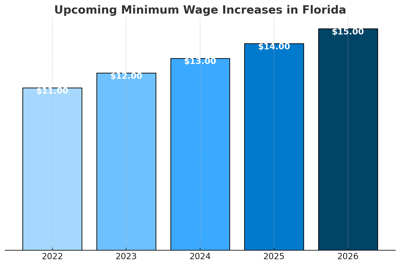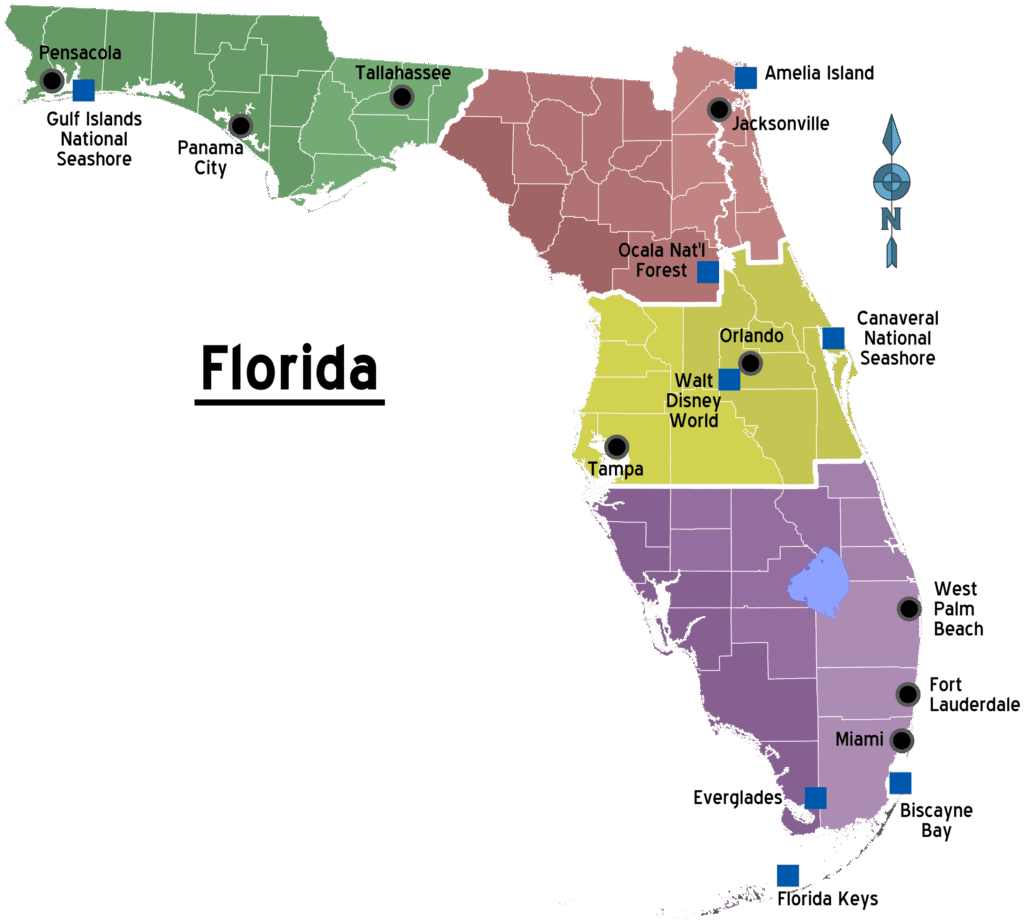As of October 2025, Florida’s minimum wage has increased to $14.00 per hour for non-tipped workers. The adjustment marks a key step in the state’s ongoing commitment to raising wages, a change expected to impact thousands of workers across the state. This increase comes as part of Florida’s 2020 Amendment 2, which aims to gradually raise the state’s minimum wage to $15.00 per hour by 2026.

The impact of the increase will be felt in various industries, with workers in sectors like hospitality, retail, and healthcare seeing a direct boost in their earnings. The wage hike is part of a broader trend seen across the U.S., where several states and localities have undertaken similar measures to address the rising cost of living and ensure that low-wage workers can keep up with inflation.
Table of Contents
Florida’s Minimum Wage Gets a Boost
| Key Fact | Detail/Statistic |
|---|---|
| New Minimum Wage (Non-Tipped) | $14.00 per hour |
| New Minimum Wage (Tipped) | $10.98 per hour (with tip credit) |
| Wage Goal for 2026 | $15.00 per hour |
| Annual Adjustment | Tied to Consumer Price Index (CPI-W) |
As of October 2025, Florida’s minimum wage has seen a substantial increase to $14.00 per hour, with further hikes planned in the coming years. This move is part of a broader trend in the state to increase the wage floor and improve the economic well-being of workers. However, the real challenge will be maintaining the balance between wage growth and the rising cost of living, especially as the state’s housing market continues to tighten.
For workers, the wage increase is an important step in improving financial security. For employers, it represents a growing challenge to balance labor costs with business viability. As Florida’s economy continues to evolve, these shifts will shape the state’s workforce for years to come.
Understanding the Minimum Wage Boost
Florida’s minimum wage has steadily increased since the passage of Amendment 2 in 2020, which aimed to boost wages incrementally until the target of $15.00 per hour is reached by September 2026. The adjustment to $14.00 per hour is the latest in a series of planned wage hikes that will benefit millions of workers across the state.
Tipped workers, however, will see a different rate. Their minimum wage will rise to $10.98 per hour, a figure that includes a tip credit of $3.02. This means employers can pay tipped employees less per hour, provided the difference is made up by tips. These wage increases will directly impact workers in hospitality, food service, and other tip-reliant industries.
For example, waitstaff, bartenders, and other tipped employees in Florida will see their hourly pay rise, which could significantly improve their overall earnings if tips are consistent. While some restaurant owners have voiced concerns about the wage hike’s impact on their businesses, others argue that the increase will allow workers to earn a more stable, reliable income.
The Long-Term Impact of Florida’s Wage Increase
While the wage hike to $14.00 is a significant step, the ultimate goal of reaching $15.00 per hour by 2026 remains a key element of the state’s economic planning. By aligning future wage increases with the Consumer Price Index for Urban Wage Earners and Clerical Workers (CPI-W), Florida aims to ensure that wages continue to keep pace with inflation. This strategy reflects broader national conversations about adjusting the minimum wage to reflect the increasing cost of living.
For workers earning minimum wage, this increase offers some relief in the face of rising housing and living costs, particularly in areas like Miami and Orlando, where the cost of living has surged in recent years. According to a report from the Florida Chamber of Commerce, the average cost of a two-bedroom apartment in Miami has increased by over 25% in the last five years, making it difficult for low-income workers to afford basic necessities.
The wage increase will also have ripple effects on local economies. As workers earn more, they are likely to spend more on goods and services, thereby stimulating economic growth. This increase in consumer spending is expected to have positive effects on retail businesses, local services, and other industries that rely on consumer demand.

The Legislative Journey: How We Got Here
The path to higher wages in Florida has been a lengthy one. In 2020, voters approved Amendment 2, which called for gradual increases in the minimum wage. The increase to $15.00 per hour by 2026 is part of a larger trend across the United States, with several other states and localities also raising their minimum wages in recent years. Florida’s wage hike plan, however, is among the most aggressive, aiming for a 25% increase over a six-year period.
Florida’s economic landscape has changed significantly since the 2020 amendment was passed. The state’s job market has recovered from the pandemic, and unemployment rates are at historically low levels. This economic recovery, combined with the ongoing wage hikes, suggests that Florida’s economy is in a period of growth, albeit with challenges related to affordability for low-income workers.
Economic studies have shown that the raising of minimum wages can benefit both employees and local economies, provided that it is done gradually and paired with other policies aimed at supporting small businesses. The impact of these increases has been studied in various regions, with many finding that higher wages can reduce employee turnover, increase productivity, and enhance consumer spending.
In contrast, critics of minimum wage increases argue that the higher labor costs could lead to job losses, particularly in small businesses. Some business owners have raised concerns that the wage hikes may force them to cut back on hiring or reduce employee hours. Despite these concerns, proponents argue that the wage hikes are necessary to address the growing income inequality in the state and across the nation.
Wage Hike’s Effect on Employers
While the increase in minimum wage benefits workers, employers in Florida are facing new challenges in adapting to these wage hikes. Small businesses, in particular, have expressed concern about the rising cost of labor, with some business owners worrying about the financial strain of meeting the new wage requirements. In response, some employers may reduce the number of hours available for workers or implement more automation to manage costs.
Despite these concerns, many economists argue that the long-term benefits of higher wages outweigh the costs. Research has shown that increasing the minimum wage can boost consumer spending, stimulate the local economy, and reduce employee turnover. These benefits, experts suggest, can help offset the initial costs for employers.
Additionally, Florida’s economic growth in recent years has provided a buffer for businesses. The state’s GDP growth rate has consistently outpaced the national average, driven by sectors like tourism, real estate, and technology. This economic resilience may help businesses adjust to the new wage structure while maintaining profitability.
Regional Disparities and the Minimum Wage Impact
One of the most notable aspects of Florida’s wage increase is the regional disparities in living costs within the state. While the wage hikes will provide relief for workers in cities like Miami, Tampa, and Orlando, those in rural areas may not see as significant an impact. In cities with higher living costs, the increase to $14.00 per hour may still fall short of providing a comfortable standard of living, particularly for workers with families.
Rural areas in Florida often have lower living expenses, but these regions also face challenges such as fewer job opportunities and lower wages in general. As a result, the $14.00 per hour minimum wage may have a disproportionate effect, helping urban workers more than those in less populated areas.
In response to these regional disparities, some local governments are exploring additional measures to ensure that workers in lower-cost regions are not left behind. These measures may include housing subsidies, transportation support, and further local wage adjustments to reflect the unique needs of different communities.

The Road Ahead: Navigating Florida’s Minimum Wage Future
Looking ahead, Florida’s minimum wage will continue to rise in the coming years. The increase to $14.00 in 2025 represents only one step toward the state’s long-term goal. By 2026, the minimum wage is set to reach $15.00 per hour. Once this target is met, future adjustments will be based on inflation, ensuring that wages remain relevant to the cost of living in the state.
For workers, this gradual increase represents an opportunity to earn higher wages over the next few years. However, it also comes with the reality that the state’s housing and living costs are expected to rise as well. Balancing wage growth with inflation will remain a challenge for policymakers moving forward.
The shift toward $15.00 per hour will likely continue to spur debates over economic policy. Advocates for higher wages argue that they will help alleviate poverty and improve the standard of living for Florida’s most vulnerable workers. Critics contend that the costs to employers and the broader economy may be too great, potentially leading to job losses and reduced economic growth.
U.S. Debt Hits $38 Trillion: What You Need to Know About the Fastest $1 Trillion Increase
How Much Snow Will New York Get This Winter? Here’s the Latest NOAA 2025-26 Forecast
$14 Billion Restored: 3.1 Million Retirees Get Full Social Security Benefits Back
FAQ About Florida’s Minimum Wage Gets a Boost
Q: When will Florida’s minimum wage reach $15.00 per hour?
A: Florida’s minimum wage is set to reach $15.00 per hour by September 30, 2026.
Q: What is the minimum wage for tipped workers in Florida?
A: The minimum wage for tipped workers in Florida has risen to $10.98 per hour in 2025, including a tip credit of up to $3.02.
Q: Why is Florida’s minimum wage being gradually increased?
A: The gradual increase is the result of the 2020 Florida Amendment 2, which mandated a series of annual increases until the minimum wage reaches $15.00 per hour by 2026.
















